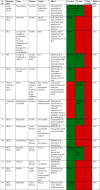Targeting COPD with PLGA-Based Nanoparticles: Current Status and Prospects
- PMID: 35309178
- PMCID: PMC8933108
- DOI: 10.1155/2022/5058121
Targeting COPD with PLGA-Based Nanoparticles: Current Status and Prospects
Abstract
Chronic obstructive pulmonary disease (COPD) is pulmonary emphysema characterized by blockage in the airflow resulting in the long-term breathing problem, hence a major cause of mortality worldwide. Excessive generation of free radicals and the development of chronic inflammation are the major two episodes underlying the pathogenesis of COPD. Currently used drugs targeting these episodes including anti-inflammatory, antioxidants, and corticosteroids are unsafe, require high doses, and pose serious side effects. Nanomaterial-conjugated drugs have shown promising therapeutic potential against different respiratory diseases as they are required in small quantities which lower overall treatment costs and can be effectively targeted to diseased tissue microenvironment hence having minimal side effects. Poly lactic-co-glycolic acid (PLGA) nanoparticles (NPs) are safe as their breakdown products are easily metabolized in the body. Drugs loaded on the PLGA NPs have been shown to be promising agents as anticancer, antimicrobial, antioxidants, and anti-inflammatory. Surface modification of PLGA NPs can further improve their mechanical properties, drug loading potential, and pharmacological activities. In the present review, we have presented a brief insight into the pathophysiological mechanism underlying COPD and highlighted the role, potential, and current status of PLGA NPs loaded with drugs in the therapy of COPD.
Copyright © 2022 Juhi Saxena et al.
Conflict of interest statement
The authors declare no conflict of interest.
Figures





Similar articles
-
PLGA-Based Micro/Nanoparticles: An Overview of Their Applications in Respiratory Diseases.Int J Mol Sci. 2023 Feb 22;24(5):4333. doi: 10.3390/ijms24054333. Int J Mol Sci. 2023. PMID: 36901762 Free PMC article. Review.
-
Synthesis, characterization, and evaluation of paclitaxel loaded in six-arm star-shaped poly(lactic-co-glycolic acid).Int J Nanomedicine. 2013;8:4315-26. doi: 10.2147/IJN.S51629. Epub 2013 Nov 7. Int J Nanomedicine. 2013. PMID: 24235829 Free PMC article.
-
Intracellular Targeting of Poly Lactic-Co-Glycolic Acid Nanoparticles by Surface Functionalization with Peptides.J Biomed Nanotechnol. 2021 Jul 1;17(7):1320-1329. doi: 10.1166/jbn.2021.3108. J Biomed Nanotechnol. 2021. PMID: 34446135
-
The Effects of Calcium Hydroxide-loaded Poly(Lactic-co-glycolic Acid) Biodegradable Nanoparticles in the ex vivo External Inflammatory Root Resorption Model.J Contemp Dent Pract. 2023 Jun 1;24(6):351-356. doi: 10.5005/jp-journals-10024-3522. J Contemp Dent Pract. 2023. PMID: 37534500
-
Biomedical applications of PLGA nanoparticles in nanomedicine: advances in drug delivery systems and cancer therapy.Expert Opin Drug Deliv. 2023 Jul-Dec;20(7):937-954. doi: 10.1080/17425247.2023.2223941. Epub 2023 Jun 23. Expert Opin Drug Deliv. 2023. PMID: 37294853 Review.
Cited by
-
PLGA-Based Nanomedicine: History of Advancement and Development in Clinical Applications of Multiple Diseases.Pharmaceutics. 2022 Dec 6;14(12):2728. doi: 10.3390/pharmaceutics14122728. Pharmaceutics. 2022. PMID: 36559223 Free PMC article. Review.
-
PLGA-Based Micro/Nanoparticles: An Overview of Their Applications in Respiratory Diseases.Int J Mol Sci. 2023 Feb 22;24(5):4333. doi: 10.3390/ijms24054333. Int J Mol Sci. 2023. PMID: 36901762 Free PMC article. Review.
-
Nanomaterials in Medicine: Understanding Cellular Uptake, Localization, and Retention for Enhanced Disease Diagnosis and Therapy.Aging Dis. 2024 Feb 22;16(1):168-208. doi: 10.14336/AD.2024.0206-1. Online ahead of print. Aging Dis. 2024. PMID: 38421835 Free PMC article. Review.
-
Nanoparticles to target asthma.Am J Physiol Lung Cell Mol Physiol. 2024 Dec 1;327(6):L964-L971. doi: 10.1152/ajplung.00248.2024. Epub 2024 Oct 29. Am J Physiol Lung Cell Mol Physiol. 2024. PMID: 39470612 Review.
-
The application of nanoparticles as advanced drug delivery systems in Attenuating COPD.Heliyon. 2024 Feb 1;10(3):e25393. doi: 10.1016/j.heliyon.2024.e25393. eCollection 2024 Feb 15. Heliyon. 2024. PMID: 38356590 Free PMC article. Review.
References
Publication types
MeSH terms
Substances
LinkOut - more resources
Full Text Sources
Medical

